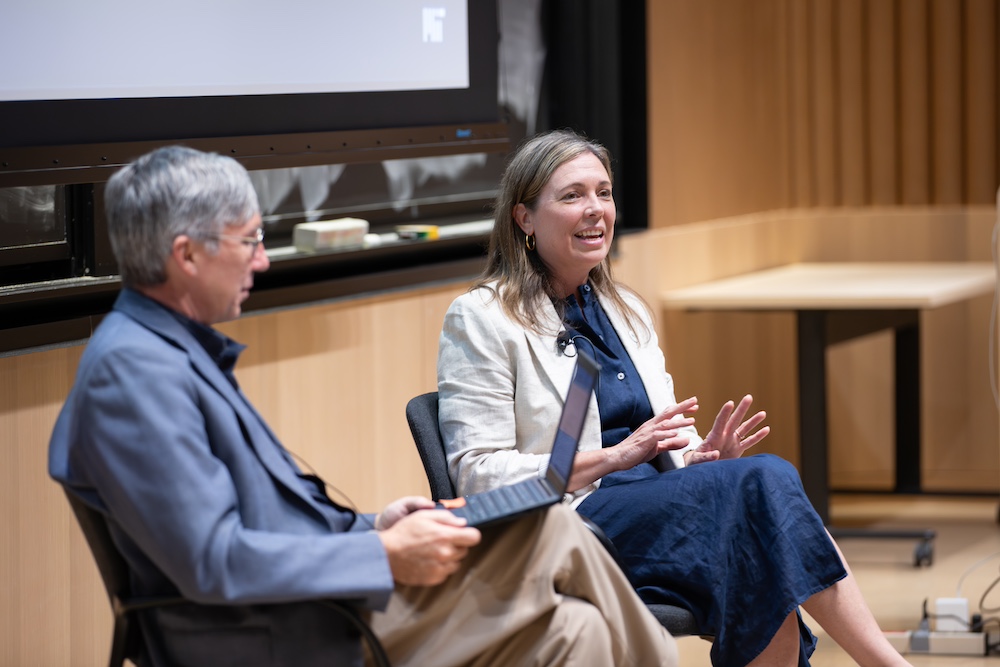
Offshore wind is a maturing industry that is becoming a permanent fixture in the energy landscape. On September 18, Alicia Barton, CEO of Vineyard Offshore, was the inaugural speaker for MITEI Presents: Advancing the Energy Transition, a new speaker series highlighting energy experts and leaders at the forefront of the scientific, technological, and policy solutions needed to transform our energy systems. Here, Barton highlights key challenges, potential solutions, and what the future may hold for this renewable energy source.
Q: Your work in the clean energy industry has been instrumental in laying the groundwork for offshore wind energy, and your efforts helped position Massachusetts as an early champion of this energy source. What have been the biggest challenges facing this industry and how have those lessons learned shaped the future of offshore wind’s role in our decarbonized future?
A: Offshore wind is an incredibly important topic for the energy future of Massachusetts and well beyond. I often think about the arc of offshore wind progress in the United States as chapters. Going back 15 years—when my own history with offshore wind started—there weren’t many people engaging with the topic yet, but Massachusetts was. In this first chapter, the state’s efforts were focused on a project called Cape Wind, which was extremely well-known and equally controversial. At that time, Massachusetts was placing a bet that if one project could launch, then others would follow. When Cape Wind was cancelled in January 2015, it made it clear that we would have our fair share of growing pains as offshore wind established itself.
Thankfully, this was also a turning point as we shifted into a second chapter: a time to focus on policy makers and stakeholders. At first, discussions with my peers in other states on offshore wind were lonely, but new Massachusetts legislation in 2016 to set up a procurement created momentum in New York and New England. While state-level support helped create this progress, a lack of permitting at the federal-level during the Trump administration significantly stalled progress that wasn’t made up until the Biden administration took over in 2021.
At this point, I believe we’re coming up on the next chapter for offshore wind. The U.S. is still a relatively new market with political risks, but the conversation about offshore wind—about decarbonization—is more than just one project. It’s about climate targets, job creation, getting our technology to the level of maturity that’s been achieved abroad, and so much more.
Q: Offshore wind is still a relatively new source of energy in this country and has faced opposition and skepticism since the beginning. How has public opinion shifted over the years and how do you engage local communities and related industries in decarbonization efforts?
A: Public perception is very relevant to our work and the federal permitting process, but it’s not monolithic. Viewshed opposition—objection to the visual or aesthetic disturbance of turbines—is still very relevant, as it has been historically. At Vineyard Offshore, we really pride ourselves on our community-first development approach as building purposeful partnerships with local communities is vital to our work. During our recent bid in NY, we had over 100 letters of support from different organizations, communities, and local elected officials.
Historically, there have also been concern over offshore wind’s impact on fishing industries, as it’s believed that offshore wind projects would restrict fishing areas. At Vineyard Offshore, we saw economic opportunities for the fishing industry within our projects. In addition to mitigation payments that compensate fisheries for any economic losses from offshore wind development, we commonly hire fishing vessels to help service projects and monitor protected marine species, particularly the North Atlantic Right Whale. If visibility of these species is ever impacted—by fog, for instance—construction cannot continue until we’re able to meet environmental protection permit conditions again. The fishing industry is uniquely qualified to be our eyes and ears for protected species and contribute to this essential aspect of offshore wind development.
Q: How can advancements in technology and policy help guide offshore wind into a new era of success?
A: Floating technology is a primary area where R&D is still needed. More traditional, fixed-bottom offshore wind is mostly common globally, so floating technology is much newer. For this technology to catch up, improvements are needed in the constructability of the floating platforms, the ability of manufacturing and port infrastructure to handle these logistics, the anchoring technology at various depths, and so much more. Continuing to advance floating technology is key for the next generation of offshore wind.
Grid interaction is another area for innovation. The success of offshore wind depends on getting more seamless points of interconnection to the electric grid. The Department of Energy awarded New England almost $400 million for the recent Power Up proposal that includes adding substations for offshore wind injection capacity. But building that kind of infrastructure takes time. Advancements in AI that could enable us to use existing grid infrastructure more efficiently could help compensate for delays in building new infrastructure.
Regarding policy advancements, improving the pace of permitting would be a game changer for offshore wind. Better funding for permitting agencies would allow these processes to be streamlined and remove roadblocks that have delayed past projects. Continued state-level support is also important for pushing offshore wind projects forward and additional support at the federal-level is essential. In this industry, progress often comes in waves of two steps forward, one step back—but every setback is a learning experience that hopefully makes the industry stronger for the next chapter.
Join the MIT Energy Initiative on October 16th to hear from Representative Sean Casten about the role of government policy in the energy transition. For more information on the next speaker in the MITEI Presents: Advancing the Energy Transition series and additional events, visit: energy.mit.edu/events